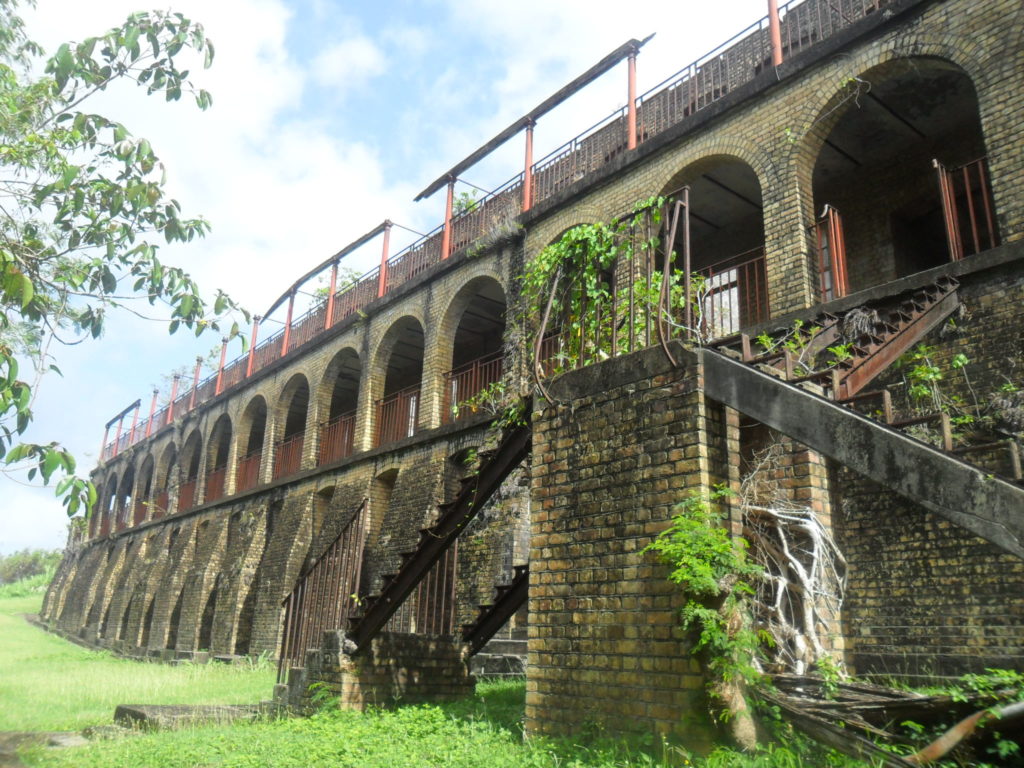-
Fair Helen of the West Indies (Weekly blog, 30 May 2016)
Posted on June 1, 2016A blog by Catherine Leonard, Secretary-General

Married Women’s Quarters, Saint Lucia
I’m told that Saint Lucia was named ‘Helen of the West Indies’ (Helen as in Troy) because the island kept switching hands between England and France, something that is very much in evidence when you visit, which I had the good fortune to do on my way back from Port of Spain last week.
I was met at the airport by the delightful Shirlene Simmons, Conservation Manager at the Saint Lucia National Trust. First stop, the Married Women’s Quarters, alongside the runway in Castries and recently vested in the National Trust by the Saint Lucia Government.
I had been impressed by the National Trust’s confidence when Germaine Joseph had outlined their ambitious plans for Walcott Place at the 2nd Conference of Caribbean National Trusts and this project only serves to underline that feeling of an organisation on the up.
The Trust has already held workshop sessions to consider the best way to renovate and reuse the site, which is destined to become a national museum but is not without its complications – the proximity to the airport being both a plus (easy to visit) and minus (perhaps not the best place to store irreplaceable archives?), parking and access issues, let alone the sheer scale of work involved.
But having now met the team and seen some of their other places, I know they can do it and I look forward to visiting again in ten years to see how they’ve got on.

Guard Cells, French and English cemeteries and Apostles Battery, Morne Fortuné, Saint Lucia
A whistle-stop tour of other sites around Castries including the Morne Fortuné (or the Hill of Good Luck – see what I mean about the whole French/English thing?): The guns at Apostles Battery (recently reinstated with the help of British volunteer and civil engineer, Godfrey Weir, who joined us at last year’s Cambridge ICNT); the Powder Magazine and Guard Cells; the Inniskilling Monument and the French and British cemeteries. Wonderful and interesting places with important and not altogether easy (either practically or emotionally) stories to tell.
 Then on to Walcott Place to meet Bishnu Tulsie, Director of the Saint Lucia National Trust. I know Bishnu quite well as he sits on the INTO Executive Committee but it was fabulous to see him on home turf, and more particularly at the childhood home of the Saint Lucian icons the Walcott brothers, a project spearheaded by the Saint Lucia National Trust.
Then on to Walcott Place to meet Bishnu Tulsie, Director of the Saint Lucia National Trust. I know Bishnu quite well as he sits on the INTO Executive Committee but it was fabulous to see him on home turf, and more particularly at the childhood home of the Saint Lucian icons the Walcott brothers, a project spearheaded by the Saint Lucia National Trust.From there, on to Pigeon Island National Landmark, one of the most important places in Saint Lucia’s history and the heart of the National Trust. A beautiful island reserve, off the North West coast and connected to the mainland by a causeway, Pigeon Island has a number of heritage attractions and amenities including the ruins of military buildings used during the battles between the French and the British (the Trust are just beginning restoration work on the Commanding Officer’s Quarters that will become their new HQ); beautiful beaches (including one where you can walk along the bottom of the sea in a contraption worthy of Jules Verne!); a fabulous restaurant (rather enticingly called ‘Jambe de Bois’ after a one-legged pirate!); and a beautiful lookout point at the top of the fort.
Amazingly, I was visiting the same day as Darryl Braithwaite, President of the Grenada National Trust, and we were both shown around by the Trust’s wonderful Murlina Murray, followed by a delicious lunch with Bishnu at Jambe de Bois, where I discovered Baron’s Hot Sauce! Some good discussions about the Grenada National Trust, what they can learn from Saint Lucia and their part in the OAS ‘Expanding the Socio-economic Potential of Cultural Heritage in the Caribbean’ project. The Grenada National Trust is leading the strand on encouraging sustainable heritage entrepreneurship through the endorsement of local tourism products and services that safeguard heritage resources and communicate their value to all audiences.
Pigeon Island is a popular wedding venue, and I can see why. It is simply breathtaking.
After lunch, I took a colourful and patois-rich (lots of ‘bonjou’s and ‘mèsi’s) drive across the island to the Saint Lucia National Trust South Office where I met Craig Henry who explained their work and set up. The office is part of the Pointe Sable Environmental Protection Area, just opposite the Maria Islands Reserve, another National Trust property. We then had a very quick visit to the nearby mangroves at Ma Koté. The mangrove is used by many different groups from charcoal makers to horse-back riders so is an important community resource.

All in all, a wonderful and inspiring day. The Saint Lucia National Trust team, now numbering over thirty, are enthusiastic and passionate about protecting Fair Helen’s patrimony, a pride echoed in their logoed outfits. They now have over 1,500 subscribing members; they are THE go to body for heritage on the island and both a critical friend and trusted partner of the Government; and in Bishnu they have a leader who has brought financial stability and good governance to the organisation. I was hugely impressed and wish them very well in their various on-going and future projects.
You can read my more formal report on the 2nd Conference of Caribbean National Trusts here.
Thanks for reading!

 44 (0)20 7824 7157
44 (0)20 7824 7157